Abstract
(1) Chemiluminenscence of rat polymorphonuclear leukocytes was stimulated by a phagocytic stimulus, latex beads (diameter = 1.01 micrometer). The maximum chemiluminescent intensity increased with bead concentration in the range 0.2--20 x 10(9) beads/ml. This response was abolished in the absence of extracellular Ca2+ (1 mM EGTA). (2) Chemiluminescence could also be stimulated by the Ca2+ ionophore A23187 in the presence of extra-cellular calcium. (3) Addition of human serum, as a source of complement, to rat polymorphonuclear leukocytes preincubated with anti-5'-nucleotidase serum resulted in a rapid stimulation of chemiluminescence, after a lag of about 40 s. (4) The stimulation of chemiluminescence by antibody plus complement was not the result of cell lysis because (i) no significant release of lactate dehydrogenase was detected at the time of the chemiluminescent response (ii) chemiluminescence was associated with the cells and not the surrounding media (iii) cell lysis did not produce chemiluminescence. (5) Chemiluminescence stimulated by antibody plus complement or by beads was inhibited by the 'calmodulin-blocker', trifluoperazine (50% inhibiton with approximately 20--30 microM). (6) Cu2+ (10(-4) M), which can inhibit C9 action, inhibited the rapid rise in chemiluminescence induced by antibody plus complement, but not the bead-induced chemiluminescence. (7) Depletion of C9 from human serum markedly inhibited the complement induced chemiluminescence response. Addition of purified C9 restored the response. (8) It was concluded that formation of the terminal complement attack complex at the surface of rat polymorphonuclear leucocytes induces a Ca2+-dependent chemiluminescence in the cells, in the absence of cell lysis.
Full text
PDF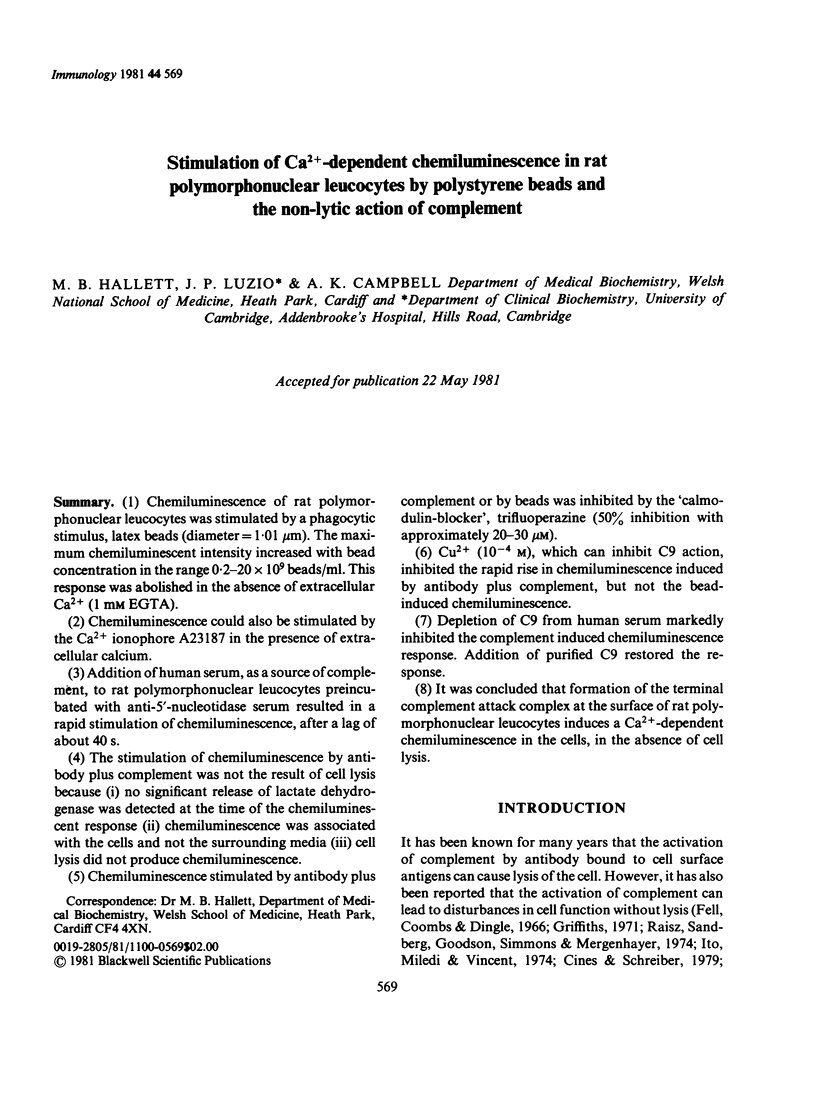
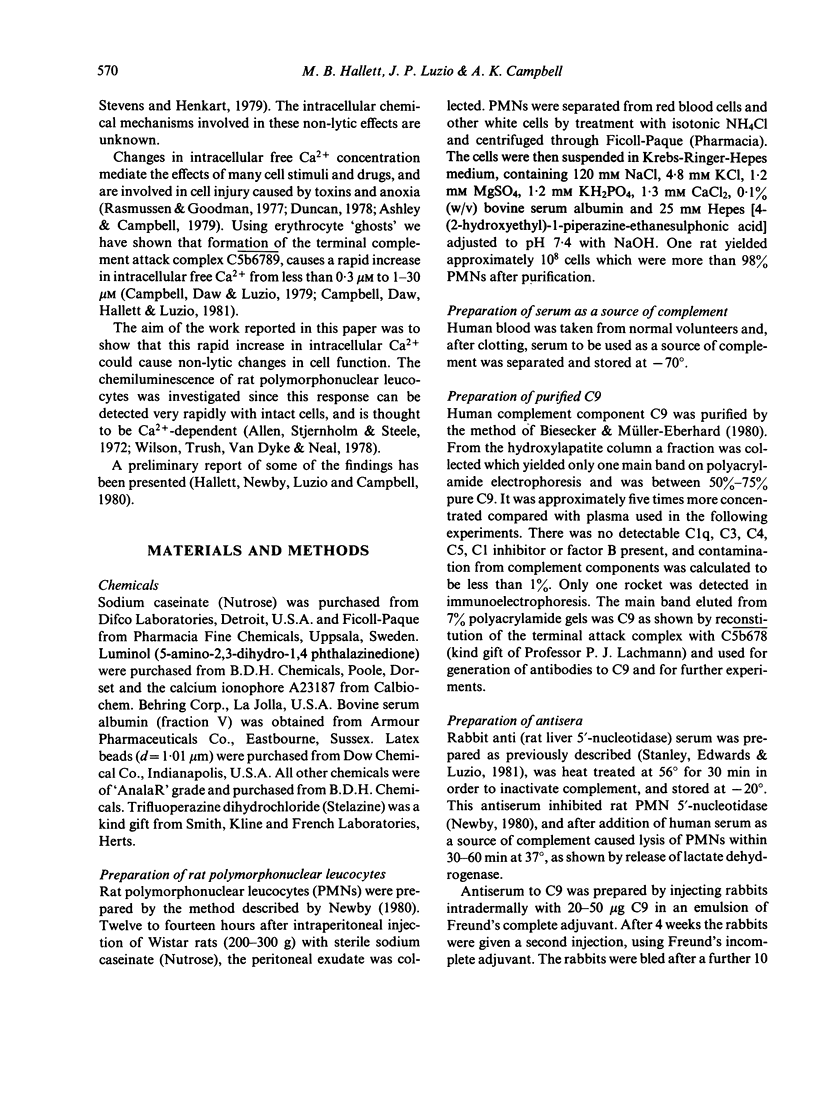
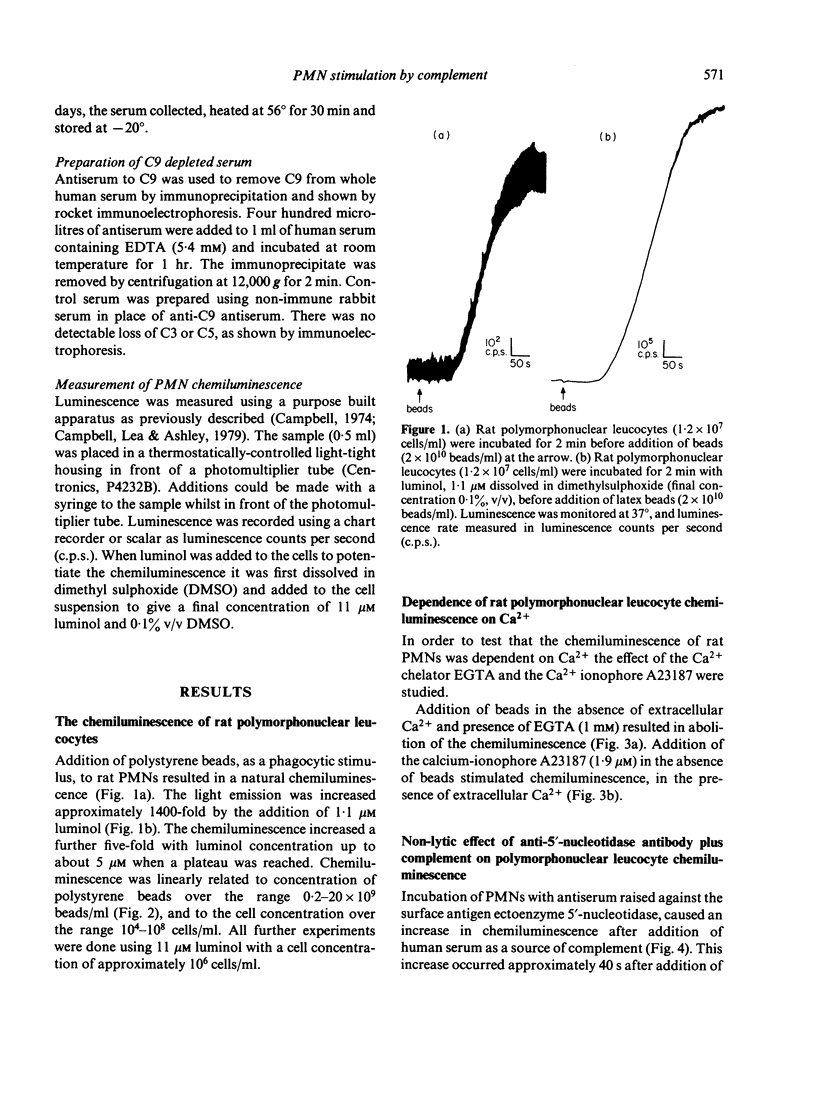
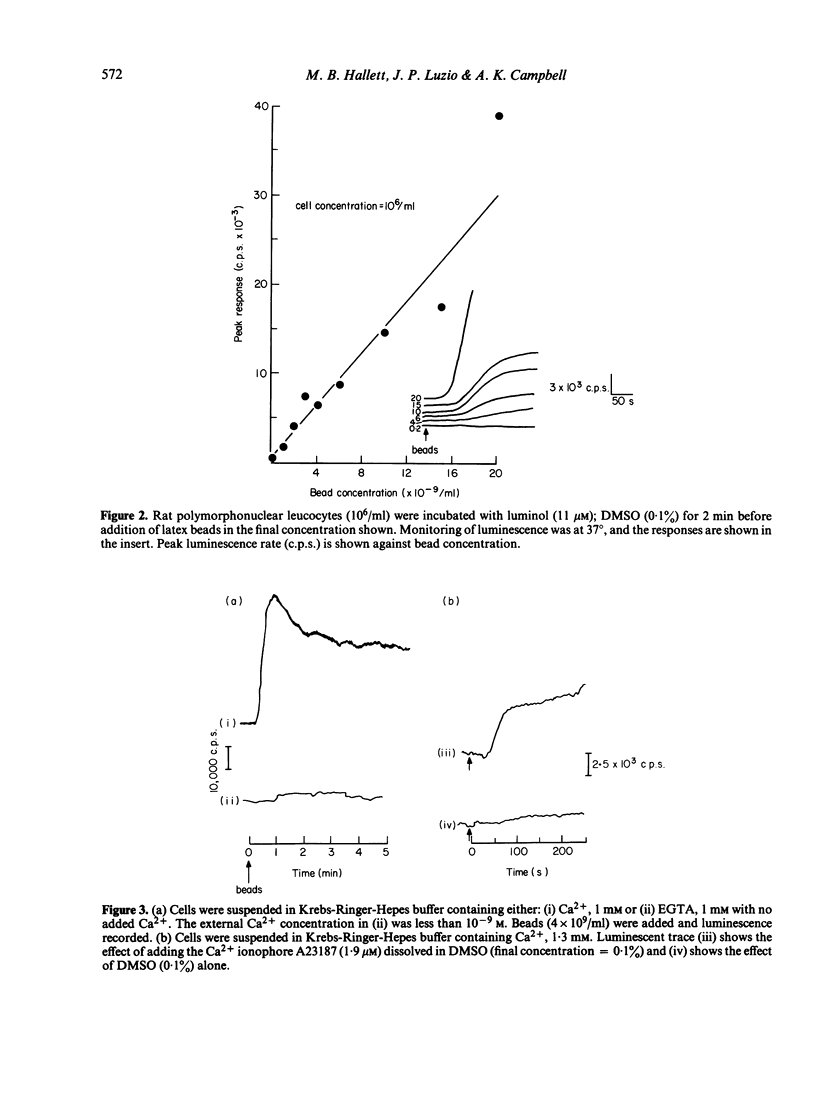

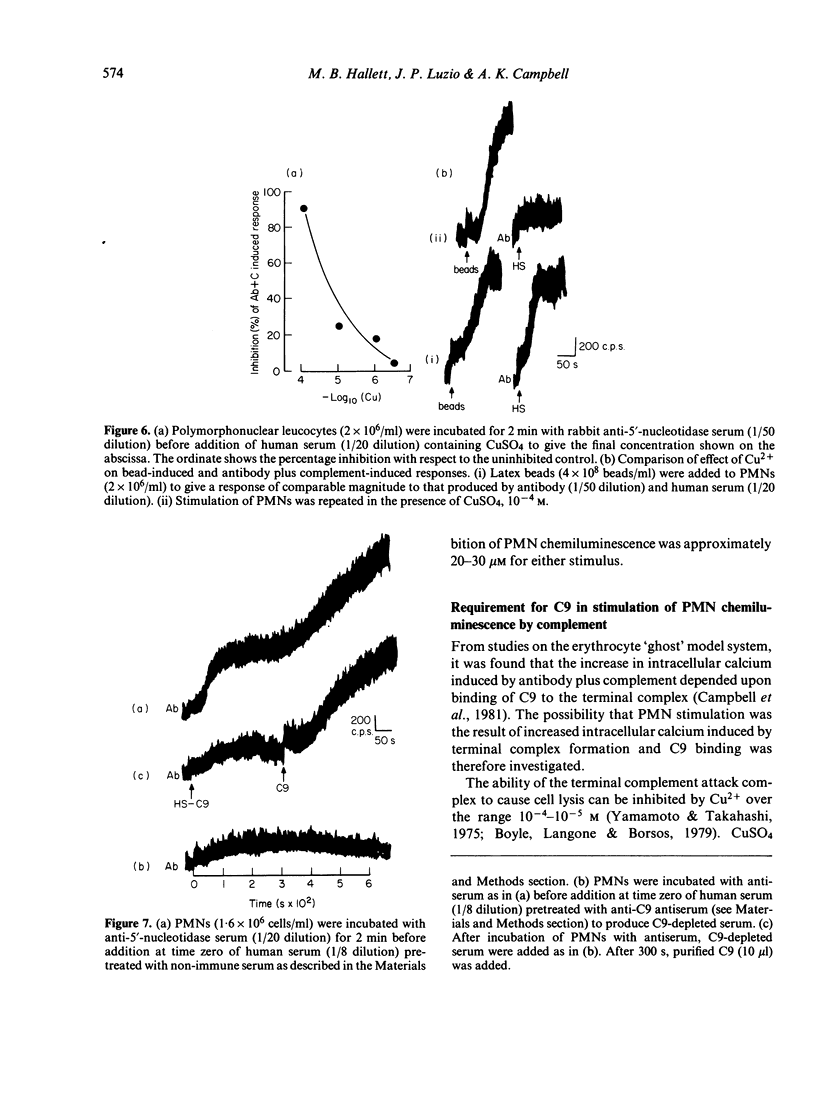
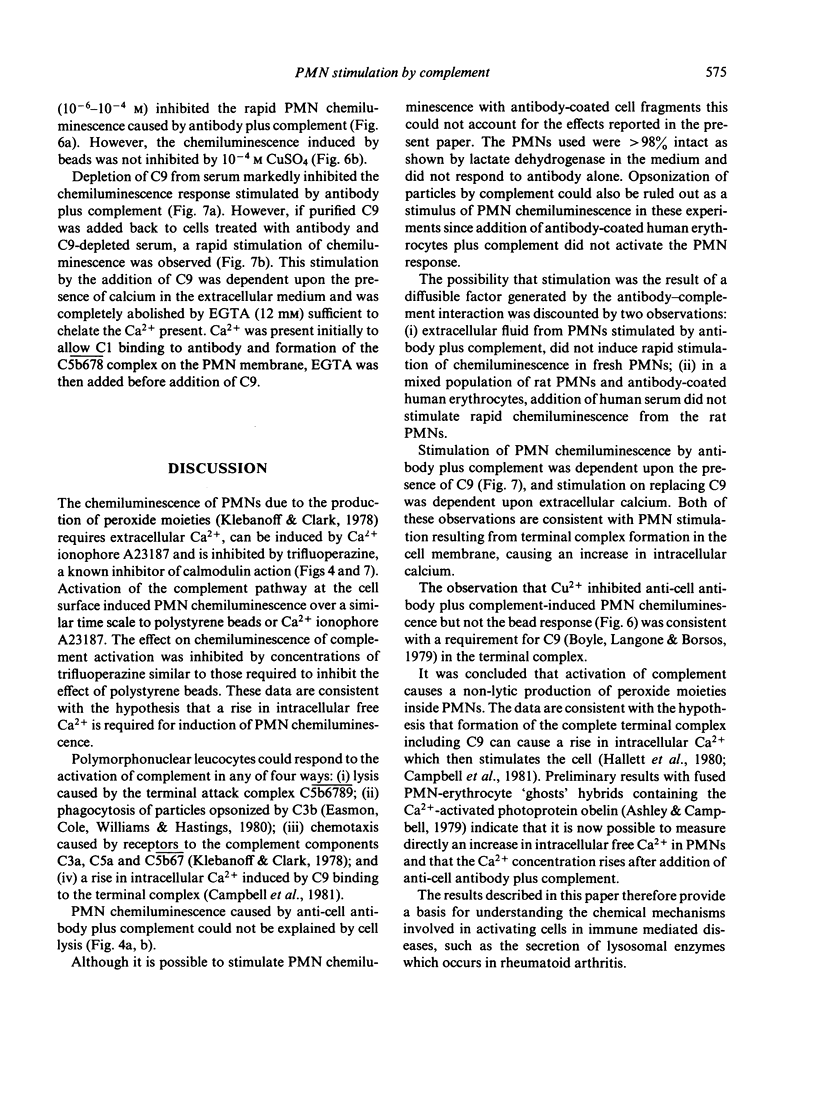
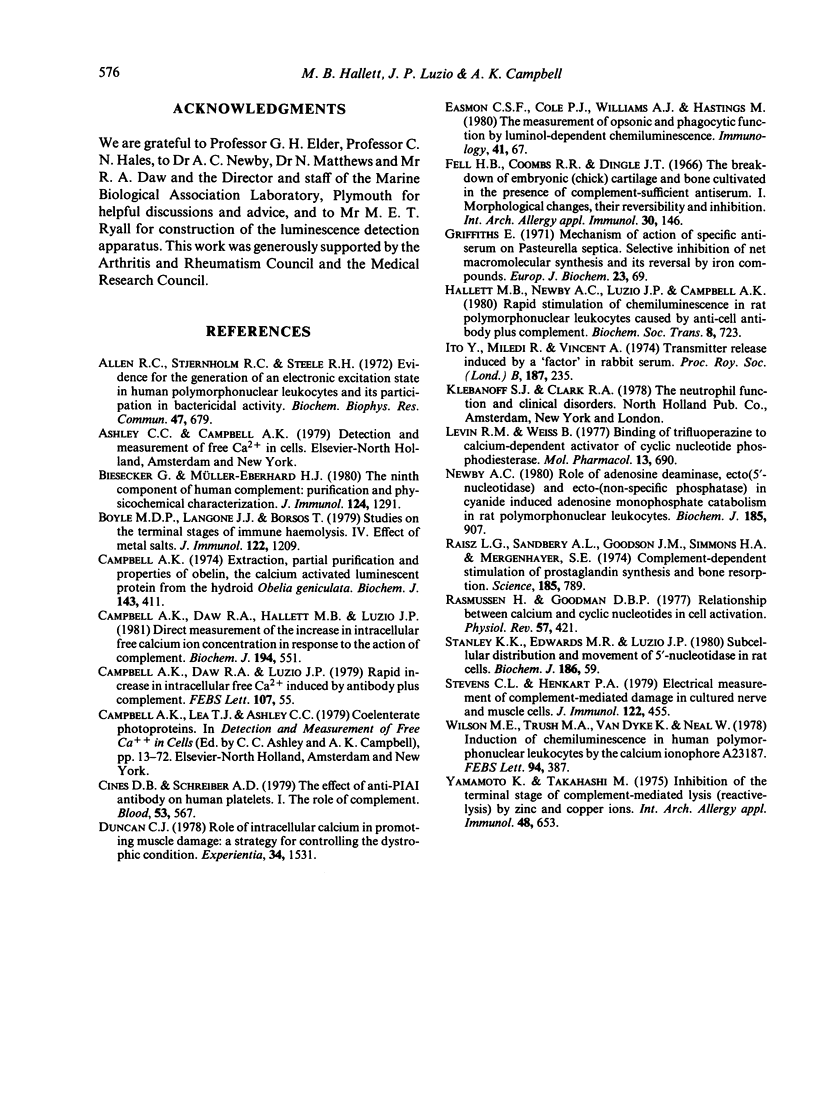
Selected References
These references are in PubMed. This may not be the complete list of references from this article.
- Allen R. C., Stjernholm R. L., Steele R. H. Evidence for the generation of an electronic excitation state(s) in human polymorphonuclear leukocytes and its participation in bactericidal activity. Biochem Biophys Res Commun. 1972 May 26;47(4):679–684. doi: 10.1016/0006-291x(72)90545-1. [DOI] [PubMed] [Google Scholar]
- Biesecker G., Müller-Eberhard H. J. The ninth component of human complement: purification and physicochemical characterization. J Immunol. 1980 Mar;124(3):1291–1296. [PubMed] [Google Scholar]
- Boyle M. D., Langone J. J., Borsos T. Studies on the terminal stages of immune hemolysis. IV. Effect of metal salts. J Immunol. 1979 Apr;122(4):1209–1213. [PubMed] [Google Scholar]
- Campbell A. K., Daw R. A., Hallett M. B., Luzio J. P. Direct measurement of the increase in intracellular free calcium ion concentration in response to the action of complement. Biochem J. 1981 Feb 15;194(2):551–560. doi: 10.1042/bj1940551. [DOI] [PMC free article] [PubMed] [Google Scholar]
- Campbell A. K., Daw R. A., Luzio J. P. Rapid increase in intracellular free Ca2+ induced by antibody plus complement. FEBS Lett. 1979 Nov 1;107(1):55–60. doi: 10.1016/0014-5793(79)80462-7. [DOI] [PubMed] [Google Scholar]
- Campbell A. K. Extraction, partial purification and properties of obelin, the calcium-activated luminescent protein from the hydroid Obelia geniculata. Biochem J. 1974 Nov;143(2):411–418. doi: 10.1042/bj1430411. [DOI] [PMC free article] [PubMed] [Google Scholar]
- Cines D. B., Schreiber A. D. Effect of anti-P1A1 antibody on human platelets. I. The role of complement. Blood. 1979 Apr;53(4):567–577. [PubMed] [Google Scholar]
- Duncan C. J. Role of intracellular calcium in promoting muscle damage: a strategy for controlling the dystrophic condition. Experientia. 1978 Dec 15;34(12):1531–1535. doi: 10.1007/BF02034655. [DOI] [PubMed] [Google Scholar]
- Fell H. B., Coombs R. R., Dingle J. T. The breakdown of embryonic (chick) cartilage and bone cultivated in the presence of complement-sufficient antiserum. I. Morphological changes, their reversibility and inhibition. Int Arch Allergy Appl Immunol. 1966;30(2):146–176. doi: 10.1159/000229803. [DOI] [PubMed] [Google Scholar]
- Griffiths E. Mechanism of action of specific antiserum on Pasteurella septica. Selective inhibition of net macromolecular synthesis and its reversal by iron compounds. Eur J Biochem. 1971 Nov 11;23(1):69–76. doi: 10.1111/j.1432-1033.1971.tb01593.x. [DOI] [PubMed] [Google Scholar]
- Hallett M. B., Newby A. C., Luzio J. P., Campbell A. K. Rapid stimulation of chemiluminescence in rat polymorphonuclear leucocytes caused by anti-cell antibody plus complement. Biochem Soc Trans. 1980 Dec;8(6):723–725. doi: 10.1042/bst0080723. [DOI] [PubMed] [Google Scholar]
- Ito Y., Miledi R., Vincent A. Transmitter release induced by a 'factor' in rabbit serum. Proc R Soc Lond B Biol Sci. 1974 Sep 17;187(1087):235–241. doi: 10.1098/rspb.1974.0072. [DOI] [PubMed] [Google Scholar]
- Levin R. M., Weiss B. Binding of trifluoperazine to the calcium-dependent activator of cyclic nucleotide phosphodiesterase. Mol Pharmacol. 1977 Jul;13(4):690–697. [PubMed] [Google Scholar]
- Newby A. C. Role of adenosine deaminase, ecto-(5'-nucleotidase) and ecto-(non-specific phosphatase) in cyanide-induced adenosine monophosphate catabolism in rat polymorphonuclear leucocytes. Biochem J. 1980 Mar 15;186(3):907–918. doi: 10.1042/bj1860907. [DOI] [PMC free article] [PubMed] [Google Scholar]
- Raisz L. G., Sandberg A. L., Goodson J. M., Simmons H. A., Mergenhagen S. E. Complement-dependent stimulation of prostaglandin synthesis and bone resorption. Science. 1974 Aug 30;185(4153):789–791. doi: 10.1126/science.185.4153.789. [DOI] [PubMed] [Google Scholar]
- Rasmussen H., Goodman D. B. Relationships between calcium and cyclic nucleotides in cell activation. Physiol Rev. 1977 Jul;57(3):421–509. doi: 10.1152/physrev.1977.57.3.421. [DOI] [PubMed] [Google Scholar]
- Stanley K. K., Edwards M. R., Luzio J. P. Subcellular distribution and movement of 5'-nucleotidase in rat cells. Biochem J. 1980 Jan 15;186(1):59–69. doi: 10.1042/bj1860059. [DOI] [PMC free article] [PubMed] [Google Scholar]
- Stephens C. L., Henkart P. A. Electrical measurements of complement-mediated membrane damage in cultured nerve and muscle cells. J Immunol. 1979 Feb;122(2):455–458. [PubMed] [Google Scholar]
- Wilson M. E., Trush M. A., van Dyke K., Neal W. Induction of chemiluminescence in human polymorphonuclear leukocytes by the calcium ionophore A23187. FEBS Lett. 1978 Oct 15;94(2):387–390. doi: 10.1016/0014-5793(78)80984-3. [DOI] [PubMed] [Google Scholar]
- Yamamoto K., Takahashi M. Inhibition of the terminal stage of complement-mediated lysis (reactive lysis) by zinc and copper ions. Int Arch Allergy Appl Immunol. 1975;48(5):653–663. doi: 10.1159/000231353. [DOI] [PubMed] [Google Scholar]


